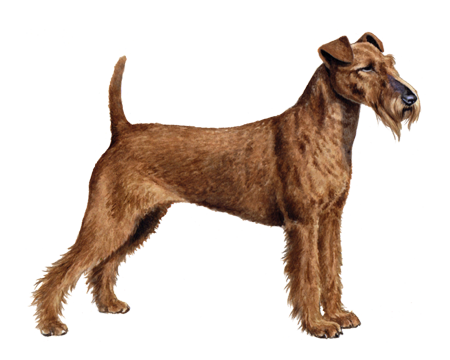
Tenterfield Terrier
The Tenterfield Terrier is an adaptable, outgoing, lively breed. With their friendly personality and loyal nature, these pups make excellent companions for children, seniors, and everyone in between.
Interested in discovering if your dog is a Tenterfield Terrier?
Check out Wisdom Panel's DNA tests.
Tenterfield Terrier Traits
General Appearance
The Tenterfield Terrier is a strong, agile working dog with an intelligent, alert expression.
Coat and Coloring
Tenterfields have short, smooth coats with no undercoat. They're predominantly white with black, liver, blue, or tan markings. Tri-color coats are common, and brindle markings are acceptable in the breed standard (but not preferred).
Distinctive Physical Traits
The Tenterfield has a medium-sized head and a strong muzzle. The breed's V-shaped ears are slightly rounded at the tip and stand erect or semi-erect. These dogs also have short, compact bodies and strong legs. And naturally bobbed tails are a common breed trait.
Tenterfield Terrier Temperament
Clever, loyal, confident dogs, Tenterfields are fearless and focused when working. But they make friendly, outgoing family pets and love attention from their people.
As playful pups, they also get along with other dogs and kids. But like most terriers, they have a strong prey drive and tend to give chase. So, they may not be the best choice for homes with cats or other small pets.
Finally, because this breed can sometimes get destructive when bored, be sure to keep your Tenterfield entertained with puzzle and chew toys whenever you have to leave them at home alone.
Tenterfield Terrier History
Tenterfield Terriers descended from miniature Fox Terriers that accompanied English settlers to Australia in the 1800s. Their small size and exceptional vermin-hunting abilities made them indispensable shipmates on the grueling months-long voyage.
These hardworking dogs established themselves in Australia not only as tenacious ratters but also as cherished family pets. They became fixtures in homes throughout New South Wales—and in the Tenterfield district, in particular.
In the early 1990s, a group of owners came together to establish a breed registry. Initially, they referred to the dogs as "Mini Foxies." However, wanting to avoid confusion between their dogs and the Smooth Fox Terrier, they ultimately settled on Tenterfield Terrier for the breed name.
The Tenterfield Terrier Club of Australia was formed in 1993. Nine years later, the Australian National Kennel Council recognized the breed.
Tenterfield Terrier Care
Nutrition
Tenterfield Terriers thrive on high-quality dog food formulated for their life stage. To help your dog maintain a healthy weight, measure their portions to avoid overfeeding and keep an eye on how many treats you're giving them. As a guideline, treats should make up no more than 10% of a dog's daily calories.
Grooming
The Tenterfield's short coat is easy to maintain. Brushing every couple of weeks to remove loose fur and the occasional bath will keep their coats clean and healthy.
To reduce your pup's chance of ear infections, check their ears regularly and clean them as needed to remove wax build-up and debris. Nail trims should also be part of every dog's grooming routine. If nails grow too long, they can cause pain and potentially lead to problems running or walking.
Lastly, good dental hygiene is vital for your pup's overall health. Dental disease is one of the most common health conditions in adult dogs—especially for small breeds like the Tenterfield. Left untreated, it can contribute to other serious issues. So, in addition to professional cleanings, establish an at-home dental care program that includes regular teeth brushing and veterinarian-recommended dental chews.
Exercise
This active, hardy breed needs regular exercise to stay happy and healthy. Consider making habits of activities such as daily walks, backyard play sessions, and games of fetch.
Training
Early, consistent obedience training using a positive, reward-based approach works well for this breed.
Additionally, all dogs benefit from socialization. Getting your pup comfortable with different people and environments when they're young will help them develop into a confident, well-mannered adult dog.
Tenterfield Terrier Genetic Health Conditions
-
Congenital Hypothyroidism (Discovered in the Tenterfield Terrier)
Congenital Hypothyroidism is a disease of insufficient thyroid hormone production. As this hormone is important in many aspects of the metabolism and development, the result is a wide variety of signs including slow growth, dwarfism, and mental impairment.
-
Primary Lens Luxation
Primary Lens Luxation (PLL) is a condition that can cause the lens of the eye to become loose and eventually displace. The disorder is caused by degeneration of the fibers that hold the lens in place.
-
Spinocerebellar Ataxia with Myokymia and/or Seizures
Spinocerebellar Ataxia with Myokymia and/or Seizures (SAMS) is a disease of the nervous system characterized by uncoordinated movements and impaired balance. This particular form may present with muscle twitching and seizures.
Knowing if your Tenterfield Terrier is a carrier or at-risk for these conditions can help you and your veterinarian plan for your pup’s lifelong care. With Wisdom Panel™ Premium, you can get results for over 200 genetic health tests.
Breed Group
Terrier
The Terrier Group ancestors were bred to hunt and kill vermin. They are often characterized as feisty and energetic dogs whose sizes range from fairly small to much larger.



































































